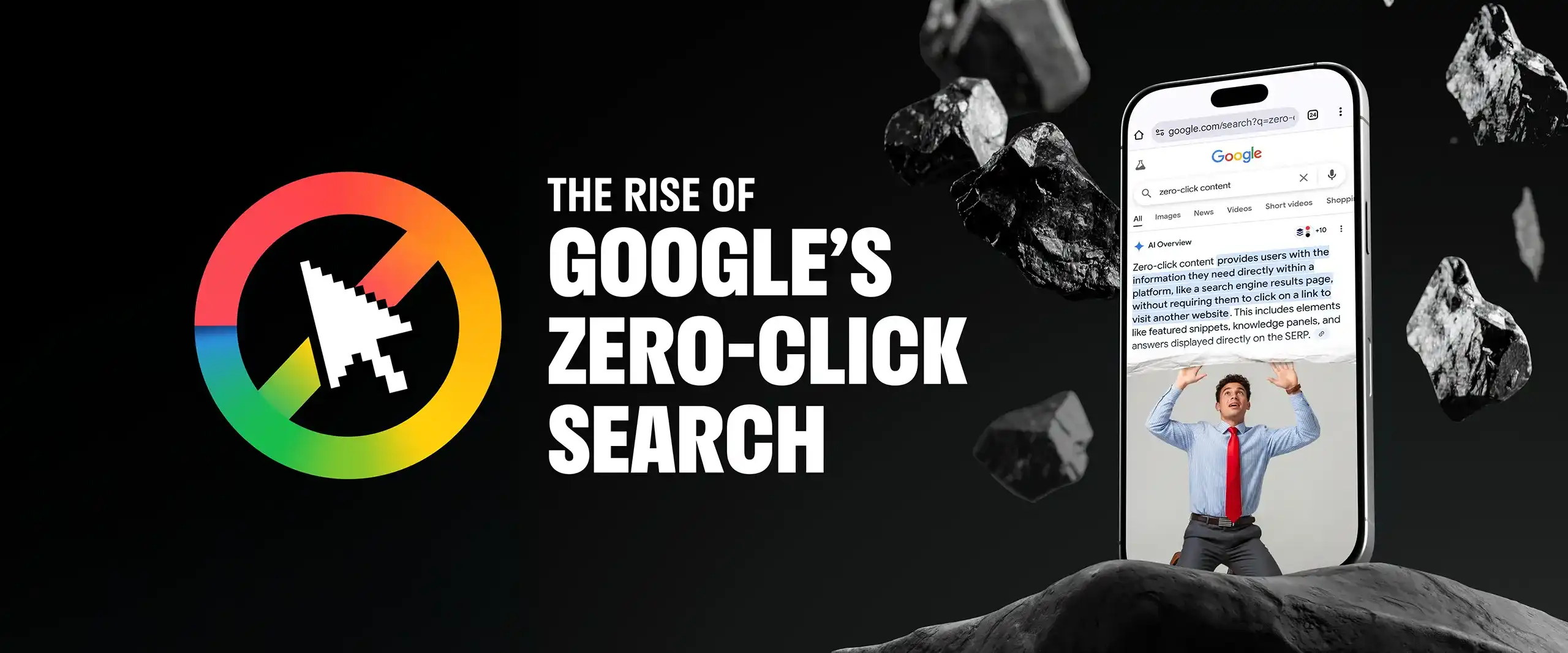Optimizing For Visibility When Users Don’t Click
Zero-click search is here to stay. With AI Overviews (AIOs) becoming more prevalent and Google’s new “AI Mode” search experience already available, marketers face the challenge of maintaining visibility with less direct traffic. They also risk becoming increasingly invisible with the rise of conversational search.
What is Zero-Click Search?
Zero-click behavior occurs when users find an answer to their query directly on the search results page without needing to click anything. Google’s AI Mode, AI overviews, featured snippets, instant answers, local packs, and knowledge panels all contribute to zero-click behavior. When Google provides you with a useful summary answer to your search query, you’re less likely to need to click through.
Types of Zero-Click Search Results
Zero-click results occur in several locations within the Google SERP outside of AI Mode, including:
- AI Overviews
- Featured Snippets
- Knowledge Panels
- Local Packs
- People Also Ask (PAA)

The Evolution Of Zero-Click
Since the introduction and expansion of AI Overviews (AIOs) a little over a year ago, we’ve seen a 30% decline in Google search click-through rates year-over-year, even as search impressions rose 49% in the same period, according to a recent study. This behavioral shift translates to more people searching similar phrases but fewer people clicking through to websites.
Nearly 60% of Google searches ended without a click in 2024, and these numbers are only increasing. As of May 2025, AI Overviews appear for up to 47% of searches, and internal testing by Google has indicated that we can soon expect AI Overviews to appear in more than 80% of informational queries.
Generative AI Overviews also occupy a tremendous amount of browser real estate, especially on mobile, where they can take up to 75.7% of the screen. When combined with sponsored positions and the potential for a featured snippet or a local map pack, the remaining real estate for organic positions is painfully small.
This growing trend underscores the need for brands to optimize their online presence so that they appear in these zero-click environments, particularly in AI Overviews and AI Mode.
Zero-Click Impact on SEO
The dramatic rise of AI search has led to a significant decline in web traffic, and both publishers, whose work can be quoted through generative AI, and marketers need to adapt to continued change. The impact on click-through rate alone from AIOs highlights their influence on zero-click behavior, with some estimates indicating a decrease of as much as 15% to 35% when an AI Overview is present.
Here are a few of the ways zero-click is impacting visibility and measurement:
- Decreased organic website traffic due to users obtaining answers directly from search results, leading to fewer opportunities for businesses to engage with site visitors.
- “Fuzzy” analytics data from AIOs and other generative search engines
- Missed opportunities in capturing visitor data and potential leads via form submissions. Less visitor data also limits remarketing capabilities via email, display ads, video, and other channels.
- Changes in how success metrics are defined, shifting emphasis from traditional metrics like click-through rates and site visits to more indirect measurements such as visibility, impressions, and channel engagement.
- Necessity for adjusted SEO and content strategies, focusing on enhancing visibility within the search results themselves rather than solely driving users to their site.
Adapting Your Strategy For Zero-Click
Evaluating the impacts of AIOs and generative search varies by industry, but they are growing fast. According to a SEMrush study, the industries experiencing the most growth are queries related to Science (+22.27%), Health (+20.33%), People & Society (+18.83%), and Law & Government (+15.18%). Additionally, 88.1% of queries that trigger an AI Overview are informational.
This evolution aligns with an ongoing trend in SEO: informational articles consistently perform well in search rankings. Google favors content that comprehensively addresses user intent, especially for top-of-funnel queries. Articles that educate, clarify, and answer common questions are more likely to get featured or AIO placements. Businesses that invest in content depth and clarity are rewarded with stronger visibility across zero-click search formats.
The way people are searching for answers to their questions or needs has also shifted to being more conversational. As people continue to use more natural language in their “conversations” with AI, looking for opportunities to engage your audience is key. Instead of looking for “What is {insert_industry}?” content that every single website in the industry has, look to answer real questions that your customers currently face.
Let’s be clear: we’re still getting some clicks, but they’re no longer the only metric that matters. In the zero-click era, your brand’s ability to appear and influence perception in AI overviews is a win in itself.
How to Optimize for Zero-Click Search?
Featured Snippets and AI Overviews
So, how can you create content that does well in generative search? Often, you’ll see the same type of informational content in organic search results as you do in the AI Overviews, so the game hasn’t completely changed. However, the overlap between AI Overview results and organic ones is declining. High-quality, informational content with succinct answers to specific questions is poised to excel in generative search across all platforms (Google AI Overviews, ChatGPT, Perplexity, etc.) and in a traditional organic search experience.
The content we see cited in generative search typically shares a few common themes. Take these steps to enhance your chances of showing up in AIOs:
- Use structured formatting, such as headers (H1/H2/H3), bullet points, and tables, to increase Google’s ability to interpret your data. (Schema markup is also always a good idea.)
- Include high-authority sources and data references in your work, where possible, as AI tools tend to reference information with trusted citations.
- Prioritize content types known to trigger rich results and/or AIOs (e.g., FAQs, How-tos, Reviews).
- Be thorough and look to answer questions relevant to your target audience. AIOs favor comprehensive informational content.
When we work on informational blogs at Ridge Marketing, we often look for opportunities around industry keywords at the top of the funnel. “What Are” and “What Is” are obvious choices when the content tends to follow an FAQ-type format.
People Also Ask (PAA)
This informational style also lends itself well to placement in People Also Ask (PAA), where Google presents users with curated Q&A content based on their original search.. The results here often share placements with sites in the AI Overview section.
Local Map Pack
If your type of business benefits at all from local search, Google My Business (GMB) placements are huge. Though technically zero-click, they can drive website traffic. Optimizing your Google My Business (GMB) is crucial. Investing time in gathering citations for your business can also reap rewards as you gain authority and improve positions and geographic reach.
What’s Next For Zero-Click Search
Google wants to keep you in their ecosystem, track your behavior, measure your interactions, and ultimately cater ads to you for their advertisers. As their systems get better at understanding search intent, we’ll continue to see the evolution of generative search. Google announced at Google Marketing Live 2025 that ads in AI Overviews are now available for advertisers, opening up a new way to translate AIOs into marketing opportunities.
Ridge Marketing’s Approach
We’ve seen this coming. The shift to AI-driven, conversational search is here, and we’re embracing it. Our approach has always been to craft compelling content that builds trust between you and your clients, and that remains unchanged.
Whether it’s crafting top-of-funnel blog content or refining local SEO strategies, we help businesses stay ahead of how search is changing because being visible matters more than ever, even if there is no click to measure.



